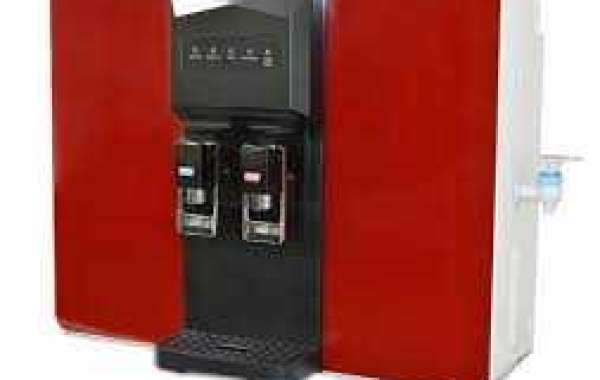The principle of operation of reverse osmosis consists in applying a certain pressure to the fluid while it is passed through a semi-permeable membrane that is capable of eliminating or retaining large molecules and at the same time allows the passage of water molecules.
This process is the opposite of natural osmosis, where the molecules of a solvent, in this case water, pass through a semi-permeable membrane from a zone of low ionic concentration to a zone of high concentration in order to balance the solution.
In this sense, in reverse osmosis the molecules of a solvent (water) pass through a semi-permeable membrane from an area of high ionic concentration to one of low concentration. When this happens, the large molecules of the different solutes present in the water are retained on one side of the membrane, while the water molecules remain on the other side.
Water quality that needs a reverse osmosis to operate properly
When the reverse osmosis process occurs, certain chemical, biological or mineral agents can affect the structure and integrity of the semi-permeable membrane. In this sense, the elements dissolved in the water can clog or reduce the pores of the membrane, causing a significant reduction in the production of clean water.
Another aspect that must be considered is the incrustation process that occurs when the concentration of mineral salts is high. In this case, the molecules of these minerals begin to saturate the solution and consequently they precipitate on the membrane, producing a decrease in the flow of water.
When this type of debris or scale accumulates around the membrane, water cannot flow easily through it, and the result is a reduction in flow rate. As a result, operating costs, energy consumption and system pressure are increased, in addition to this, the membrane suffers significant damage that requires it to be replaced prematurely.
On the other hand, when the membrane becomes clogged, an increase in pressure occurs and therefore the pumping system needs to work more to overcome this differential, thereby increasing energy consumption.
To avoid this series of problems, the water must be treated before subjecting it to the reverse osmosis process, in order to eliminate as much colloids as possible, such as clays, floccules and suspended solids. In addition to this, it is advisable to place special filters that allow the elimination of organic matter, oils, biological agents, microorganisms and protozoa, as well as sulfates, carbonates, calcium and other minerals that may precipitate in the semi-permeable membrane.
Multimedia filter or deep bed filter to install before reverse osmosis
Systems required for reverse osmosis pre-treatment
In general, there are two systems for the pre-treatment of the water before being subjected to the reverse osmosis process. The first is the filtration treatment and in the second place we have the chemical treatment. However, it is advisable to carry out a physical-chemical analysis of the water that will be treated to verify the amount of elements present in it, and based on this, different processes will be used to guarantee its quality.
One of the basic systems is the one related to the filtration or removal of solids present in the water, for this purpose filters of different sizes are used to efficiently remove any impurities. In addition to these, activated carbon filters are also used that facilitate the removal of chemical and organic substances.
Other filters used is the so-called water softener or softener, whose function is to eliminate or reduce the minerals present in the water, such as calcium and magnesium. In some cases, ultraviolet light can be used to destroy certain microorganisms or bacteria.
In addition to this, some systems require the use of biocides, such as chlorine, however this must be applied in conjunction with a bisulfite, since chlorine can significantly affect the semi-permeable membrane.
On the other hand, the levels of pH, hardness and alkalinity should be monitored to avoid the precipitation of carbonates, and also use scale inhibitors to prevent their formation.
1. Deep bed filters for osmosis pre-treatment
Deep bed filters, also known as multimedia filters, are used when there is a high concentration of suspended solids in the water that will be subjected to the reverse osmosis process. This class of filtration systems are very necessary since they allow the effective removal of large particles, as well as those of smaller size.
Multimedia or deep bed filters are made up of different layers of filter material, grouped in such a way as to allow uniform filtration throughout the entire material. Inside they can contain various materials, such as gravel, sand and anthracite, which, thanks to their difference in densities and porosity, trap the solids present in the water as it flows through it.
One of the advantages of deep bed or multilayer filters is the ability to treat a high flow rate of water when compared to a single material household water purifier in bd filter. In addition, with this system a much more clarified water is obtained since it allows the removal of particles of different sizes.
What is the role of a deep bed filter in this pre-treatment?
It retains solids and suspended particles that can damage activated carbon. Helps the carbon not be saturated by these solids.
Multimedia filter or deep bed filter to install before reverse osmosis
Multimedia / Deep Bed Filter Prices:
Deep Bed Filters with Clack Valves, Carbon Filters with Digital Clack Valves
Válvula WS 1.25
Quick view
TO CLOSE
2.0 ft3 12 × 52 ″ deep bed filter, sand and anthracite bed, Clack valve.
$11,179IVA Inc.
Deep Bed Filters with Clack Valves, Carbon Filters with Digital Clack Valves
Válvula WS 1.25
Quick view
TO CLOSE
0.75 ft3 8 × 44 ″ deep bed filter, sand and anthracite bed, Clack valve.
$8,651IVA Inc.
Filter with Manual Valve, Aquatrol Tank and Purago Valve
Quick view
TO CLOSE
Multimedia Filter 10 × 54 ″, 1 ″ Manual Valve
$4,894IVA Inc.
Filter with Manual Valve, Aquatrol Tank and Purago Valve
Quick view
TO CLOSE
Multimedia Filter 9 × 48 ″, 1 ″ Manual Valve
$3,592IVA Inc.
2. Activated carbon purifier for osmosis pre-treatment
Other systems for the pre-treatment of water before undergoing the reverse osmosis process is that of activated carbon. This system allows the adsorption of polluting particles on the carbon surface.
This process is very efficient and is achieved thanks to the extensive and porous structure of activated carbon, however, there are some elements that must be considered during the adsorption process, such as the surface extension of the carbon, the size of the pores, the pressure, the temperature, the size of the particles to be retained and the contact time between the water and the surface of the carbon.
Activated carbon filters reduce the damage caused by particles to the reverse osmosis membrane, it is also effective in eliminating the bad smell and taste of the water, as well as reducing the presence of different types of contaminants, such as chlorine, trihalomethanes, pesticides, solvents, heavy metals, and some industrial wastes.
To produce the activated carbon used in these filters, various organic materials must be burned at high temperatures, resulting in a much more porous product with a larger contact surface that guarantees a much higher level of adsorption than common carbon.
Finally, it is important to note that activated carbon filters cannot eliminate viruses, bacteria or microorganisms, so some other system must be used that allows their removal.
Why is the charcoal equipment installed before the softener?
Coal retains organic pollutants and removes chlorine through a chemical reaction. It is installed before the softener since the resin has a low tolerance to chlorine, if a cationic resin receives chlorine it is damaged and you will need to change it in much less time than if it receives chlorine-free water.
Activated Carbon Filter, Activated Carbon System, Charcoal Equipment Before Reverse Osmosis
Activated carbon systems prices:
Filter with Manual Valve, Aquatrol Tank and Purago Valve
Quick view
TO CLOSE
10 ″ x54 ″ 1.5 ft3 Activated Carbon Purifier. 1 ″ manual valve
Valued at 5.00 out of 5
$4,017IVA Inc.
Filter with Manual Valve, Aquatrol Tank and Purago Valve
Quick view
TO CLOSE
2.0 ft3 12 ″ x52 ″ Activated Carbon Purifier. 1 ″ manual valve
$5,320IVA Inc.
Filter with Manual Valve, Aquatrol Tank and Purago Valve
Quick view
TO CLOSE
8 ″ x44 ″ 0.75 ft3 Activated Carbon Purifier. 1 ″ manual valve
$2,823IVA Inc.
Filter with Manual Valve, Aquatrol Tank and Purago Valve
Quick view
TO CLOSE
1.0 ft3 9 ″ x48 ″ Activated Carbon Purifier. 1 ″ manual valve
Valued at 5.00 out of 5
$3,377IVA Inc.
3. Water softeners for osmosis pre-treatment
Water softeners are systems that improve the quality of “hard” water, thanks to an ion exchange process that takes place on a resin plate. Basically a softener, or also called a water softener, has the ability to remove the calcium and magnesium present in the water to replace them with sodium ions.
The main reason to use a water softener for reverse osmosis pre-treatment is that this kind of system prevents the formation of mineral salt crystals that can clog the pipes, connections and the different parts that make up the system. In addition, water treatment also allows the increase in the quality of the water by making it more drinkable for human consumption.
Water softeners are manufactured in different sizes, and are effective in places where it is required to maintain a continuous flow of water. These systems are generally equipped with a resin tank, as well as the means to produce the ion exchange, safety valves, and gauges. They can also be designed according to the necessary technical specifications and installed in parallel systems.
Why is the pre-reverse osmosis softener installed?
In the first stage we remove sediment, in the second organic matter and chlorine and in the third stage we remove hardness. The hardness embeds the reverse osmosis membranes and therefore the membranes stop retaining mineral salts, in addition, the hardness can totally or partially plug the membranes and cause a high loss of flow and water quality. The water that reaches the membranes must be almost free of hardness (Calcium and Magnesium).
Reverse Osmosis Pretreatment Systems, Multimedia Filter, Carbon and Softener
Prices of water softeners:
Aquatrol Valve Water Softener, Water Softener
Electromechanical Aquatrol Valve Series AQT-59SM
Quick view
TO CLOSE
Softener 10×54″, Aquatrol AQT-56SM metering valve, 1.5 ft3 resin.
$10,905IVA Inc.
WS1EE Clack Valve Water Softener or Softener
Quick view
TO CLOSE
12 × 52 ″ softener, Clack metering valve, 2.0 ft3 resin.
$18,651IVA Inc.
water softener with manual valve-1
Quick view
TO CLOSE
8 × 44 ″ softener with 0.75 ft3 of resin, 1 ″ manual valve.
$5,183IVA Inc.
water softener with manual valve-1
Quick view
TO CLOSE
9 × 48 ″ softener with 1.0 ft3 of resin, 1 ″ manual valve.
$6,626IVA Inc.
4. Antifouling (Optional Treatment):
What are and how are scale produced in reverse osmosis membranes?
The reverse osmosis water treatment process creates saline flows with high concentrations of sediments and minerals that can cause scale on the system membrane. Not all treated water is the same, this means that its chemical composition varies remarkably, and consequently the type of scale that will be produced will also change depending on it.
In basic terms, a scale is a precipitate or a crust that forms on the surface of an object continuously and progressively, due to the presence of high concentrations of mineral salts in the water flow, such as carbonate of calcium, calcium sulfate and calcium silicate.
In general, incrustations are produced by chemical and physical changes in water saturated with mineral salts, in this regard, when the concentration of mineral ions exceeds the solubility limit of the fluid, these precipitate and tend to unite forming crystals. , which over time grow to become large deposits of solid material called incrustations.
Types of fouling in reverse osmosis membranes
There are several types of fouling in reverse osmosis membranes, however the most common are the following:
Calcium Carbonate: this type of scale is very common in reverse osmosis membranes, it has a white powdery appearance and occurs when calcium carbonate precipitates, it is generally easy to remove with acid antiscalant.
Sulfates of:
Calcium: this type of scale usually forms when water is high in sulfate content, creating long, pointed structures on the membrane surface that are difficult to remove.
Barium: This product is formed when barium ions join with sulfates, producing a very poorly soluble compound that tends to precipitate rapidly.
Strontium: this compound is also called "celestite" and is caused by the union of strontium ions with sulfates. The solubility of this product is very poor, and like barium sulfate it precipitates once formed.
Silica: This scale is deposited on reverse osmosis membranes in the form of aluminosilicates and is generally difficult to remove.
Calcium Phosphate - Calcium phosphate scale is very common in reverse osmosis water treatment and is formed when calcium ions are bonded with phosphates.
Magnesium hydroxide: this compound is also called “Brucite” and is generally produced in systems whose membranes work with high pH levels.
Antifouling for reverse osmosis membranes. What are they?
Antiscalant are chemicals that have been designed to effectively remove the different types of scale that naturally occur on reverse osmosis membranes during water treatment and purification.
These chemicals are capable of removing, eliminating and preventing the formation of different types of scale that tend to form on the surface of reverse osmosis membranes. In this sense, antiscalant works as inhibitors and is made up of polymers with negative charges that interrupt the fusion of the elements and therefore their precipitation.
When is it advisable to use an antifouling?
To know when to use an antifouling within a reverse osmosis water treatment system, the first thing to do is a physical-chemical analysis of the water to be treated. With this kind of tests, we will have all information related to the concentration levels of the different compounds and mineral salts present in the fluid, and with this we will be able to know the most suitable type of antiscalant, as well as the appropriate dosage.
Types of antiscalant
In general, antiscalant is designed to interfere with the reactions that produce the precipitation of minerals present in water, and we can group them into three types:
Those that inhibit the precipitation threshold: this type of antiscalant has the ability to inhibit or increase the maximum saturation level that a solution can support so that the mineral salts present in it precipitate.
Crystal modifiers : these antiscalant are capable of modifying the crystal structure of the scale in such a way as to soften it so that it loses its adhesion properties.
Antiscalant as dispersant: this group of antiscalant has the ability to absorb certain crystals to increase the ionic charge of the solution, and consequently it manages to keep the crystals separated so that they cannot precipitate.
Recommendations to keep a reverse osmosis system in good condition
Reverse osmosis systems are widely used, both in industry and at home, during the treatment of water used for human consumption, for this reason, it is important that we keep this type of system in good condition. To begin we must make a regular change of the filters, since these tend to accumulate sediment, solids and bacteria that deteriorate the quality of the water.
Apart from changing the filters, it is very important to maintain the membranes to guarantee their proper functioning. In general, this is done using jets of water or pressurized air, in order to eliminate the residues that may be lodged in it. In addition, these membranes can be washed with some chemical products, which have been developed specifically for this type of activity.
anti-fouling or anti-scaling for m reverse osmosis membranes
Prices of antiscalant, chemical tanks and metering pumps:
Quick view
TO CLOSE
Prominent Beta Chlorine Dosing Pump
$15,640IVA Inc.
Vitec 4000 Silica antifouling
Quick view
TO CLOSE
Inhibitor Incr. Vitec 4000 Silica, 20 liter presentation.
$15,868IVA Inc.
Clack brand storage tank designed for chemicals
Chemical storage tank
Quick view
TO CLOSE
16 and 35 gallon chemical tank.
$1,144 – IVA Inc.$3,625
3 Recommendations to keep a reverse osmosis system in good condition
To finish the article, we want to leave you 3 recommendations that will help you keep your Reverse Osmosis in good condition. Reverse osmosis systems are widely used, both in industry and at home, during the treatment of water used for human consumption, for this reason, it is important that we keep this type of system in good condition.
To begin we must make a regular change of the sedimentation cartridge that is prior to osmosis, since these tend to accumulate sediment, solids and bacteria that deteriorate the quality of the water.
In addition, it is very important to maintain the membranes to guarantee their proper functioning. The membranes can be washed with some chemical products, when the product water flow, the water quality or the pressure decrease up to 15% it is probable that your membrane requires cleaning.
Measure the inlet and outlet water quality of the system. We recommend using a daily log to capture the TDS levels at the entrance and exit of your equipment, so that with this data you can tell if the quality of the water has decreased and evaluate whether a chemical cleaning or a replacement of the membranes is adequate.
Conclusion:
In addition to these systems, it is important to point out that depending on your water quality you may need other systems, such as: Catalysts to remove iron and manganese, Systems to increase the pH of the water, among others.










